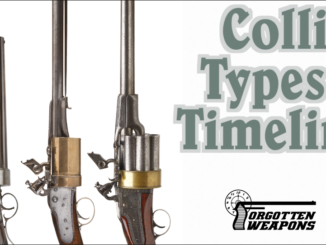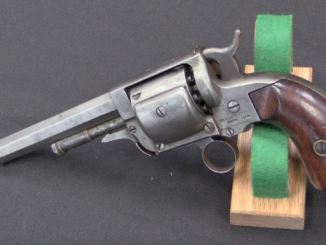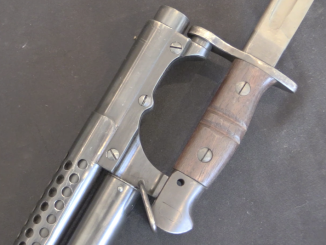0:00 – Purpose of the Fix
6:03 – The 8.6mm Blackout Cartridge
12:33 – Rifle Features
21:13 – Disassembly
29:35 – My Complaints
31:49 – At the Range
There is a ton to go over in this video…I noticed the Fix when it first came out, but it didn’t become really interesting to me until the version in 8.6mm Blackout hit the market. Fundamentally, the Fix is a very light, modular, and ergonomic bolt action utility rifle. In 8.6mm, I think it is a magnificent hunting weapon – virtually silent while offering excellent terminal performance with a heavy expanding projectile.
I am going to be using this rifle with an AGM Rattler TS35-640 thermal optic in Midnight Brutality, so stick around for that video tomorrow!




from bond
First question that occurs to me, here, is this: What the hell happens when you try chambering this round in a 7.62X51 weapon? What happens when you chamber 7.62X51 in an 8.6 Blackout weapon?
Magazine interchange is all well and good, until you’ve introduced the potential for someone to grab the wrong magazine in the dark or in a moment of inattention, and then inadvertently try shooting the wrong cartridge out of the weapon? That ain’t what I’d term smart.
If there’s one thing I’ve taken away from people’s misadventures with .300 Blackout, it would be that introducing a new cartridge which can be loaded into existing magazine systems and then loaded into the wrong weapon for that cartridge? That’s just… Incredibly stupid. If the idiots behind this don’t introduce some means of preventing that from happening, they’re fully deserving of the lawsuits they have coming.
Using another magazine for your new cartridge is economical engineering. What it isn’t is “smart”, unless you design in deliberate safety features to prevent that new round from loading into the new weapon.
I have to question the overall wisdom of this entire concept, TBH.
Errr… That second-to-last paragraph ought to read “…safety features to prevent that new round from loading into the old weapon.”
With the implied meaning as well of “preventing old round from loading in new weapon”.
Sheesh. Some days, I’m telling you. The English just eludes me…
“(…)What happens when you chamber 7.62X51 in an 8.6 Blackout weapon?(…)”
I was unable to unveil C.I.P. specification for chamber of latter cartridge, so I am unable to calculate if it would be possible to ram 7,62×51 into chamber for latter cartridge.
Just using smaller caliber bullet should not cause catastrophic failure see e.g. https://www.youtube.com/watch?v=mtWpbf6yNxA however experiment would be need to determine what would happen in case of 7,62×51 in 8.6 Blackout fire-arm.
Most obviously, it probably won’t take the rifling properly, so you’ll likely have degraded bordering on nonexistent usable accuracy.
Since the 8.6 x 43 cartridge is shorter overall than 7.62 x 51 and has the shoulder further back, I would expect problems with chambering, namely either failed bolt closure (good) or a crush fit if the bolt is worked with vigor (bad). The latter likely ending in a pressure peak event whether the bullet takes the rifling or not, due to the case neck being forced into the barrel’s leade’.
Eight millimeters doesn’t seem like much, but it can make a great deal of difference if it happens to be in the wrong place at the wrong time.
clear ether
eon
the shoulder location is further back on .338 blackout compared to .308, so you’ll not get the blackout bolt closed on a .308 case
the other way around. 338 case in .308 chamber is looking unpleasant. possible case separation from grossly excessive headspace
also the possibility of the unsupported portion of the bullet bulging or buckling rather than swaging down to.308.
Really bad cartridge size combinations do exist, but they’re seldom using the same magazine
perhaps it’s a case of avoiding having guns in both calibres
examples of that would be:
12 gauge and 20 gauge shotguns. 20 gage case rims stick in the front of a 12 gauge chamber and give a very easily recognisable barrel burst when a proper 12 gauge gets fired behind it.
.222 Remington, .223 Remington, .222 Remington Mag, 5.6×51 RWS. each of those can be mistaken for the next one up and will give an excess headspace situation if you chamber and fire it
.270 Winchester and .280 Remington. .270 will chamber in the .280 with grossly excessive headspace.
The same thing may be true for some guns chambered for the Gibbs style wildcats where the shoulder position is moved forward, although gibbs did fire form cases by loading the bullets out to engage the rifling to provide some resistance to the firing pin strike, and relying on the extractor to prevent the case from sliding forwards.
Now I want to see some of those neat innovations built into a handsomer gun. You’ll forgive me, I hope, for thinking that if we’re going to take the life of a beautiful animal — and we are, because the herds must be cropped for the sake of all of us, man and beast — it can be done with a beautiful weapon.
One of those CZ short-action Mausers in 7.62 x 39 could probably be rebarreled to 8.6 x 43, resulting in a rather trim, elegant carbine.
Scout scope or regular scope installation at your option. Myself, I’d go for a Mannlicher-style stock with a schnabel forend and my old standby, a Bushnell 3-9 x 50 in the “traditional” position.
cheers
eon
@eon
you’d need to open the CZ bolt face and single stack magazine up…
possibly lengthen the receiver and bolt too
It’s interesting that when .222 and then .223 were introduced, Brno and Krico took different routes to enlarge their respective versions of the ZKW465 to take the longer cartridges
Brno took the lazy route and opened up the magazine and ejection ports and shortened the bolt stop without changing the length of the action
Krico took the longer route and the Krico bolts and receivers are longer than the Brno Cz, by taking this route, Krico was able to retain the better bolt guiding of the longer receiver bridge of the prototype.
I checked out the locking system of a Brno Fox a few years ago, it’s actually better than a rifle that was marketed in the 80s in 7mm rem mag!
The locking system’s bearing and shear areas on the gun I measured are roughly comparable to published figures for the Weatherby Mk7 Varmintmaster which was factory chambered in .22-250 Remington. so, a very similar case to the blackout.
a friend has a Krico 600, which is a slightly enlarged adaptation of the CZ design, in .308. I’ve not got it measured yet.
“Now I want to see some of those neat innovations built into a handsomer gun.(…)”
https://faxonfirearms.com/firearms/8-6-blackout/ claims that 8.6 Blackout complete firearms, available for the AR-10 platform, pistol and rifle, as well as bolt action pistols and rifles so it seems that (any? some?) AR-10 platform could be rebuild to use said cartridge.
For the effectiveness of 8.6 as a hunting cartridge, just follow any of Kevin Brittingham’s social media.
He’s been busy taking one of everything in Africa.
Pretty clear to me that this was designed specifically for feral swine.
I appreciate the explanation of the 7.62; 6.5 Creedmoor; 8.6 Blackout evolution and the logic in magazine dimensions. That said (or restated) the need for anything but a three-round magazine (standard or proprietary) would not come up and in most cases would be contrary to hunting regulations in most US States. Feral Swine are a special case. One could call it “hunting”. I believe in the humane harvest and elimination of invasive/introduced animals. Ian has posted on this and I applaud him for that.
So, great, expensive rifle for feral swine but no bueno for deer or elk. If you are going to hunt deer or elk and want to preserve your hearing, there is a compound bow out there for you and some really serious effort involved in putting meat on the table. I hunt have hunted with a front-stuffer and thought that Ian’s guided hunt post was one of the worst he has put out. Guided hunt, no clean kill, ridiculously expensive gear and shooting at far too long range. I’m going out to gig some invasive bullfogs!
Ultimately ensuring that the correct round is used is the user’s responsibility, not the manufacturer’s.
Designing a reliable magazine isn’t a simple process, and it’s completely unreasonable to expect manufacturer’s to design when an existing item will serve.
I would beg to differ with you on this point. If your design allows for these mistakes to be made, you are the one who f*cked up, not the user. Excellence in design means your design doesn’t have to rely on the user always doing the right thing “just because”.
Case in point would be the various weapons you can put together wrong, and get something that only sort of works. The M60 gas system comes to mind, as an example. Or, the bolt/firing pin assembly… Or, the sear…
You design to avoid Murphy, not make his job easier.
Meanwhile, I suppose everyone’s forgotten the whole issue of 7.92×57 v. 7.62×63. You cannot make everything foolproof because fools are so persistent. There’s some classic internet images of a destroyed Swedish rolling block that explained to its suddenly deceased owner why you shouldn’t randomly force cartridges into the chamber until you find one that fits & fires. The .473 case diameter family interchange issues have been around for over a century and have seemingly failed to wipe out humanity.
As I understand it, those pictures of the detonated swede rolling block actually have a different origin; it’s that after they were surplussed, a fair number of the swede guns had their chambers rebored for the. 500 Black Powder Express. Problem is, the only way to load for a 500 BPE these days is with .500 NITRO Express brass, which has identical dimensions. What killed that poor fellow was some kind of terrible fuck-up in which a modern elephant-killer ended up mixed in with the blackpowder handloads. Same dimensions, same headstamp even, and the rest is written in blood.
That, incidentally, is why no matter what modern guns for the cartridge I may pick up, I’m not ever going to buy or load 45-70 above trapdoor spec unless some really serious turnover in my collection takes place
“(…)You cannot make everything foolproof because fools are so persistent.(…)”
https://www.reddit.com/r/ukraine/comments/12fx7t7/a_russian_military_propagandist_attempted_to/
No matter what, it’s still inherently and inescapably stupid to design your products so as to make it easier for the fools.
If you can chamber a round or put it in a magazine, then you’d better be able to fire it safely. It’s that damn simple; if you design a new cartridge that fits into an existing magazine and will still chamber in the old cartridge’s chamber? You’re a damn fool, and deserve every single lawsuit you have headed your way.
I won’t have .300 Blackout in my possession, ever. It’s just plain stupid to set things up for that sort of accidental-yet-not-actually-accidental situation. You design so as to prevent these things, not enable them.
hmmmm
Several current makers of Mauser 98 type rifles, use both a smooth taper for barrel location in the receiver ring, and bolt lockup in the the barrel itself rather than the receiver, allowing both easy take down (which the Fix doesn’t have) and very easy, no tools changing between barrels in different calibres.
An example of this is Armenia Concari at Lecco in Italy (same town as Fiocchi cartridges).
Shultz and Larsson had 4 lug bolts, but with better extraction camming than most 3 lug actions have now, back in the 1950s.
The bolt handle and multiple cocking cams is very reminiscent of the Brno / Cz ZKW 465 and the Krico 400 to 900 models.
The design reason behind Mauser going to a one piece bolt made from a single piece of steel in his Belgian model of 1889, and continuing to the 1898 and beyond…
was to ensure that no parts could be left out or get out of alignment. if the bolt handle was down, the bolt was locked. That could not be said of some other rifles then or now, and that includes the fix.
Previous Mauser models and the M1888 commission rifle (which put front locking lugs on a mauser 1871 bolt) had detachable bolt heads. With effort and common idiocy, these could be fired without a bolt head.
Steyr, even incorporated a special bolt release in its 1888 based “Mannlicher” rifles, to prevent the bolt from being inserted without its head. it was a recognised problem, and it keeps coming back.
auto incorrect strikes again
should read;
Armeria Concari at Lecco
It looks like a love child from a Mauser 66 and a VSS Vintorez:)
Let me know if you need a new welcoming home for that Steyer Scout. I would put it to good use here in Wyoming
BMS Milcam
How does the 8.6 Blackout compare to the .338 Whisper?